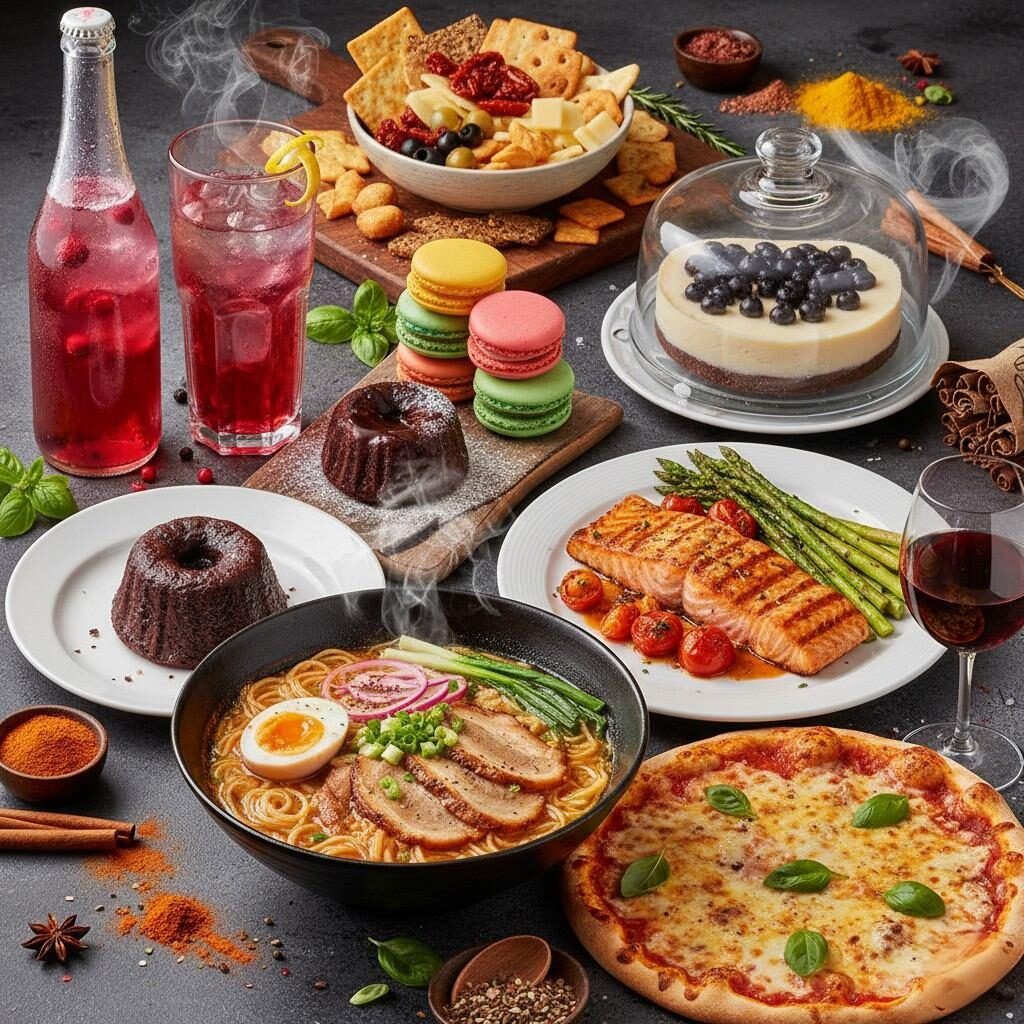Author: R&D Team, CUIGUAI Flavoring
Published by: Guangdong Unique Flavor Co., Ltd.
Last Updated: Sep 25, 2025

A Symphony of Flavors: A Culinary Collage
In the fiercely competitive food and beverage landscape, the success of a product often hinges on a single, powerful factor: flavor. While packaging, branding, and nutritional value play crucial roles, it is the sensory experience—the delightful burst of taste and aroma—that creates a lasting impression, fosters brand loyalty, and ultimately drives consumer acceptance. A product can have the perfect texture, the most appealing color, and an impeccable health profile, but if the flavor fails to connect with the consumer, it will likely fail in the marketplace.
The modern consumer is more discerning than ever. They seek not just sustenance, but experiences. They crave authenticity, novelty, and comfort, often all at once. For food and beverage manufacturers, meeting these complex demands is a significant challenge. This is where the art and science of food-grade flavors become indispensable. Appealing flavors are not merely additives; they are the core components that define a product’s character, mask undesirable notes, ensure consistency, and unlock new avenues for innovation.
This comprehensive article explores the multifaceted role of food-grade flavors in capturing the consumer’s palate. We will delve into the sensory science behind how we perceive flavor, examine the psychological drivers of our preferences, navigate the technical landscape of flavor creation and application, and discuss the strategic importance of flavor in product development. For manufacturers, understanding these dynamics is the first step toward creating products that don’t just sell, but resonate.
What we call “flavor” is a far more complex phenomenon than simple taste. It is a sophisticated, multisensory integration of signals interpreted by the brain. To engineer appealing flavors, one must first understand the biological and neurological processes that govern this perception.
The journey of flavor begins on the tongue, which is covered in thousands of taste buds, each containing taste receptor cells. Traditionally, we recognize five basic tastes, which serve as the foundational pillars of flavor:
The vast majority of what we perceive as flavor—up to 80%—is actually derived from our sense of smell, or olfaction. The human olfactory system can distinguish between trillions of different scents. As noted by researchers at Rockefeller University, the human capacity for discriminating smells is far greater than previously thought, highlighting its central role in our sensory world. (Citation 1: Rockefeller University News, “Humans Can Discriminate More Than 1 Trillion Olfactory Stimuli,” 2014).
Flavor perception from aroma occurs through two pathways:
Orthonasal Olfaction: The sensing of aromas through the nostrils when we sniff food before eating. This builds anticipation and sets expectations for the taste to come.
Retronasal Olfaction: The sensing of aromas that are released from food in the mouth during chewing and swallowing. These volatile organic compounds (VOCs) travel up the back of the throat to the olfactory receptors in the nasal cavity. This is what creates the rich, nuanced, and distinctive character of a food, distinguishing a cherry from a raspberry or a basil from a mint.
It is the intricate dance between taste and retronasal aroma that creates a cohesive flavor profile. Without aroma, an apple and an onion would have a remarkably similar taste—primarily sweet and textural.
Flavor perception is further modulated by other sensory inputs:

The Flavor Alchemist at Work
Food-grade flavors are highly concentrated preparations of aromatic substances, meticulously designed to be added to food and beverage products to impart, modify, or enhance their flavor. Their creation is a blend of natural sourcing, scientific analysis, and creative formulation. According to the U.S. Food and Drug Administration (FDA), the term “flavor” on a product label signifies that its purpose is purely for flavoring rather than for nutritional value. (Citation 2: U.S. Food and Drug Administration, Code of Federal Regulations Title 21, Section 101.22).
Flavors are broadly categorized based on their source and chemical composition.
This is the fastest-growing category, driven by consumer demand for “clean labels” and perceived healthfulness. The official definition of a natural flavor can be complex, but in essence, it means the flavoring constituents are derived from a natural source, such as a fruit, spice, vegetable, meat, or dairy product. The flavor itself is obtained through physical processes like distillation, extraction, or fermentation.
Within this category, there are further distinctions:
Flavors are supplied in various forms to suit different product applications:
Beyond simply adding a pleasant taste, flavors are functional tools that solve a wide array of technical challenges in food and beverage production. Their strategic application is often the key to a product’s commercial viability.
This is one of the most critical functions of modern flavor systems. Many ingredients that are desirable for their nutritional benefits come with inherent flavor challenges:
Consumers expect a strawberry yogurt to taste like a fresh, ripe strawberry. Flavor technology allows manufacturers to deliver this authentic experience consistently. Flavorists can create profiles that are “juicy,” “ripe,” “jammy,” or “green” to perfectly match the desired product character. Flavors can also be used to enhance existing tastes, making a tomato sauce more savory or a chicken broth richer.
Raw agricultural materials vary in flavor intensity and quality depending on the season, crop variety, and origin. Relying solely on these ingredients can lead to significant batch-to-batch inconsistency. Food-grade flavors provide a standardized solution, ensuring that a product tastes the same in January as it does in June, regardless of where it is manufactured. Furthermore, many natural flavors degrade when exposed to heat, light, or oxygen during processing and storage. Stable flavor systems, especially encapsulated ones, are designed to withstand these conditions and deliver their full impact to the consumer.
The flavor industry is at the forefront of food innovation, helping brands tap into the latest consumer trends. A recent report on global food trends highlighted the growing consumer desire for both comfort and adventure in their food choices. (Citation 3: Mintel, “2024 Global Food and Drink Trends,” 2023). Flavors are the primary tool for addressing these desires:

The Power of Professional Flavors: A Benefit Infographic
Perhaps no category better illustrates the power of flavor technology than the plant-based meat alternative market. The initial challenge for this industry was not just texture, but overcoming the inherent flavors of plant proteins. As reported by major news outlets, the mainstream success of companies like Beyond Meat and Impossible Foods was largely dependent on their ability to create a sensory experience that closely mimicked conventional meat. (Citation 4: Forbes, “The Secret Ingredient In The Plant-Based Food Boom,” 2021).
This was achieved through a sophisticated, multi-pronged flavor strategy:
In a saturated market, flavor is the ultimate differentiator. It is the voice of your product, communicating quality, authenticity, and innovation directly to the consumer’s senses. From overcoming the technical hurdles of new ingredients to creating a signature taste that defines a brand, the role of appealing food-grade flavors is more critical than ever.
The journey from a raw ingredient to a beloved consumer product is complex. It requires a deep understanding of sensory science, a mastery of chemical formulation, a keen eye on market trends, and an unwavering commitment to quality and safety. By partnering with a dedicated and experienced flavor house, manufacturers gain access to not just a portfolio of ingredients, but a team of experts committed to solving challenges and co-creating success. The right flavor can transform a good product into a great one, ensuring it not only gets accepted by consumers but gets chosen, time and time again.

Sharing Joy: The Ultimate Flavor Experience
The difference between a market leader and a forgotten product can be a single, perfectly balanced note. If you’re looking to overcome technical challenges, enhance your product’s appeal, or innovate with the latest flavor trends, our team is here to help.
Contact us today for a technical consultation with our expert flavorists or to request a free sample tailored to your application:
Contact our QA & R&D team at:
📩 [info@cuiguai.com]
📞 [+86 189 2926 7983]
Or request samples via our site: [www.cuiguai.cn]
Copyright © 2025 Guangdong Unique Flavor Co., Ltd. All Rights Reserved.